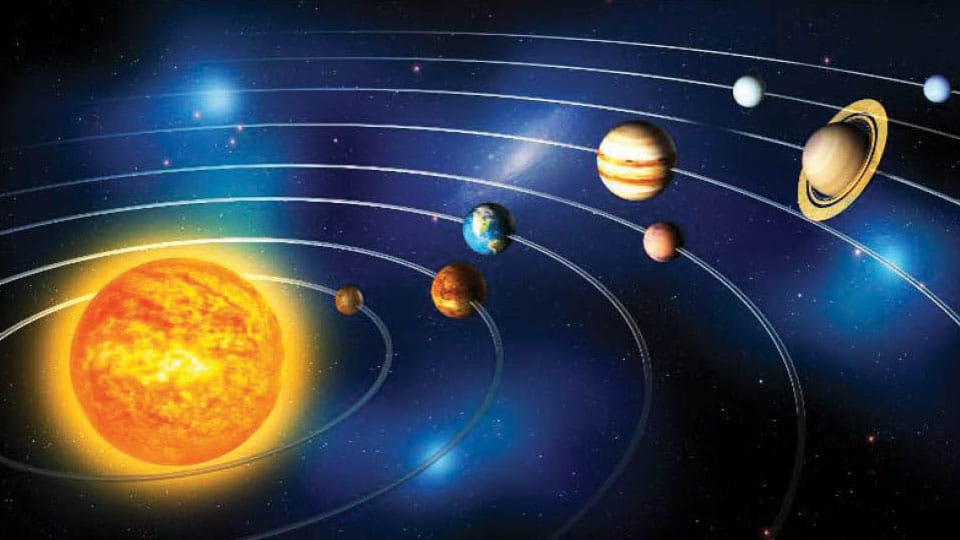By Dr. S.A. Mohan Krishna, Amateur Astronomer
Planet Watching’ is one of the most fascinating experience. If we witness the sky on a dark, clear night we can see hundreds of stars and a few terrestrial planets. They are not alike; they are of different colours and differ in brightness. Planets move slowly among the stars, following patterns that repeat over months or years. In July-August, Indians are privileged to witness 5 planets in the morning sky. We can witness Mercury, Venus, Mars, Jupiter and Saturn to fall in line forming a natural planetary conjunction.
This is a fabulous astronomical spectacle for amateur astronomers, astronomy connoisseurs and general public. The innermost planet of the solar system is Mercury. As the Solar System’s innermost planet, its orbit keeps close to the Sun, so the planet is visible only shortly before or briefly after sunset. It is clearly perceptible as a magnitude star at approximately two-monthly intervals alternating between evening and morning twilight. During times of best visibility, Mercury stands low in the twilight for about three to four weeks. It looks like a warm-white star, and binoculars often help us to spot it.
Spotting Mercury means searching twilight skies for a dot of light. Presently, it can be seen at around 5.30 am before sunrise and is also regarded as ‘Hostile Planet’. In a telescope, Mercury’s apparent size and brightness vary according to its distance from Earth and place in orbit, with the planet showing phases like Moon. Very occasionally, the Earth, Mercury and the Sun accomplish planetary conjunction and the planet is then seen to transit the sun as a small dark spot crossing the solar disc. We can locate Mercury in the morning sky particularly in ‘Gemini’ constellation.
Venus is second major planet in order of distance from the Sun. Even novice star-gazers will have no difficulty finding brilliant Venus, often called the ‘morning’ or ‘evening’ star. Venus can be the brightest object in the sky after the Sun and Moon and allows a near-circular path some 106 million kilometres from the Sun, taking 225 days to complete one orbit. Venus will be presently visible over the eastern direction before sunrise and remains visible over the western horizon throughout the month. It can be clearly seen at 4 am in ‘Taurus’ constellation. In a telescope, Venus’ opaque clouds usually appear featureless. Sometimes, however, observers are able to make out faint, dark patches on the white disk, probably the cloud features. During the third and last week of July, the planet can be clearly seen in the eastern sky with mesmerising brightness.
Mars is the resplendent yellow-orange planet in the solar system. The magnitude of Mars decreases from -1.5 at the beginning of the month to about half of that, -0.60 by month’s end. Look for Mars to be high over the southeast direction before sunrise, and setting a few hours before sunset. During night also, we can clearly see the red planet at around 1.30 am. Mars can appear at any place in the sky on the ecliptic, rather than always staying near the Sun, like Mercury and Venus. On first viewing Mars by telescope, beginners are often startled by its smallness. Even at its closest approach, Mars appears no larger than a lunar crater. Typical first looks show an amber disk, some faint markings, and maybe a whitish polar cap.
Jupiter is the second brightest planet after Venus. A few weeks before and after the opposition in July 2020, Jupiter will be very bright, reaching a visual magnitude of about -2.5 to – 2.6. This will be an excellent opportunity to observe Jupiter, its Great Red Spot and Jupiter’s four largest satellites namely Io, Europa, Ganymede and Callisto. These celebrated satellites of Jupiter can be seen in a binocular also.
A telescope with a magnification of 40 times or above is preferred in observing Jupiter. The apparent magnitude or brightness factor of Jupiter during July and August is – 2.6. Note that, the negative sign convention indicates that, the brightness will be maximum and for the positive sign convention, the brightness will be minimum. For example, the magnitude of full moon will be about – 12 and it depicts exceedingly good resplendence.
Jupiter not only beams at its brilliant best for the year, but stays out all night long! From Mysuru, Jupiter will be perceptible between 7 pm and 6 am next day. It reaches the highest point in the sky at around midnight. Jupiter can be seen in the vicinity of the constellations ‘Capricornus’ and ‘Sagittarius’.
Analogously, on July 20, Saturn will have rendezvous with Earth and shall be the right time to witness this gorgeous ringed planet. Saturn is the sixth planet from the Sun and the outermost planet perfectly noticeable with the unaided eye. The imperative physical distinctiveness like magnitude, composition, internal configuration, and atmosphere advocate an overall similitude to Saturn. Saturn’s rings has unmitigated, disc-like, effortlessly conspicuous with even a small telescope, which envelops Saturn.
The specialty of this astronomical happening is that, the planet Saturn becomes more beautiful, also the best time to witness the planet. Throughout the night Saturn is discernible and more resplendent. From Mysuru, Saturn will be perceptible between 7.30 pm and 6 am. It reaches the highest pinnacle in the sky at around midnight. Saturn can be seen in the vicinity of the constellations ‘Capricornus’ and ‘Sagittarius’. Saturn appears cream-white in colour and is among the brightest star-like objects in our sky. Saturn in 2020 rises earlier and continues to creep higher above the south-eastern horizon earlier each night. Today, Saturn will have very close encounter with Earth and is the best time for observing Saturn. Jupiter and Saturn have planned to dominate this year captivatingly !
Enjoy watching these five dominating planets in July. Other than Mercury, other planets can be seen through naked eyes avoiding the sophistication. Telescopes for planet watching need sturdy mountings and high-quality optics. Most observers use powers of 200x or less, due to unsettled seeing. Also useful are coloured filters, which accentuate specific features on planets.








Recent Comments